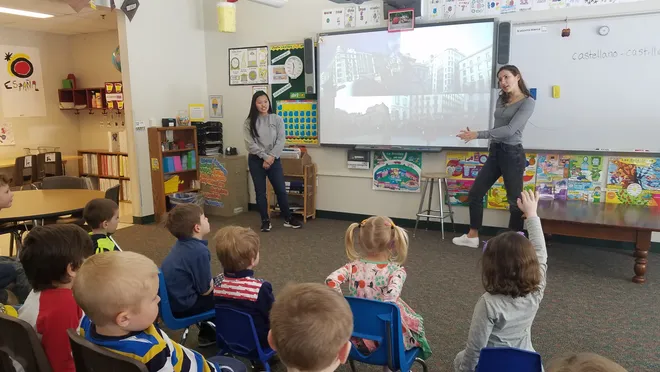Are you looking for easy ways to teach Spanish in your elementary school? If so, read on for my top tips to incorporate teaching Spanish language into your everyday classroom routine. As the world becomes ever more connected, speaking an additional language becomes increasingly important.
Benefits of learning a foreign language
- Enhances academic performance
- Fosters appreciation and respect for diverse cultures
- Deepens comprehension of the English language
- Nurtures problem-solving abilities
- Expands access to diverse career paths and networking opportunities
Starting language learning at a young age is advantageous, making it crucial to introduce foreign languages in elementary school. For educators seeking enjoyable and straightforward methods to integrate Spanish into their classrooms, here are some effortless ways to incorporate Spanish language teaching today:
Spanish Language Displays
Classroom displays and bulletin boards offer excellent opportunities to showcase the Spanish language. Here are some engaging ideas:
Spanish Language Birthday Display
Transform your birthday bulletin board by replacing the month names with their Spanish counterparts. This simple adjustment exposes students to Spanish months while learning their birthdays. Consider singing “Happy Birthday” in Spanish on students’ special days for added practice.
Spanish Language Calendar
Present your classroom calendar in Spanish, incorporating days of the week and months in Spanish to reinforce vocabulary acquisition. You could even include Spanish weather terms for further language exposure.
Timetable
Enhance your daily timetable by including Spanish translations for each subject, providing students with familiarity with Spanish subject terms.
Spanish Number Display
Enrich your number display by adding Spanish number words (1-20 and beyond) to facilitate counting practice in Spanish. Students can refer to these posters for additional reinforcement.
Label Objects in Spanish
Label common classroom items with their Spanish names, such as “puerta” (door), “silla” (chair), “escritorio” (desk), “lavabo” (sink), etc. Consistent exposure to Spanish vocabulary on everyday objects aids in vocabulary retention and acquisition.
Spanish Songs
Singing songs proves to be one of the most effective methods for learning a foreign language. The catchy rhythm aids in word retention and adds an element of enjoyment to the learning process. The repetitive nature of songs, coupled with engaged listening, facilitates easy word recall in a relaxed setting. Utilize YouTube to play songs with displayed lyrics for pronunciation practice. Songs that involve actions further enhance vocabulary retention and add to the fun factor. If a song lacks actions, creating your own can be just as engaging! Immersing oneself in the music of Spanish-speaking countries offers valuable cultural insights.
Here are some entertaining songs for Spanish language instruction:
“Heads, Shoulders, Knees, and Toes” – Ideal for learning body parts in Spanish.
“Hokey Pokey” – Singing this in Spanish offers a fun approach to learning simple verbs and body parts.
“I Can Sing a Rainbow” – An effective tool for teaching Spanish colors.
“If You’re Happy and You Know It” – A lively song for teaching actions and body parts, with added enjoyment through movement.
“1, 2, 3, 4, 5 Once I Caught a Fish Alive” – Perfect for introducing numbers 1 to 10 in Spanish.
Bilingual Books
Spanish bilingual books offer students the opportunity to read stories in English while also comparing and contrasting them in Spanish. This aids in vocabulary recognition and understanding of Spanish sentence structure. Here are some bilingual Spanish books to add to your classroom library:
¡Fiesta!
by Ginger Foglesong Guy
Introduces counting to 10 as three children prepare for a party, selecting food, games, and music.
¡Siesta!
by Ginger Foglesong Guy
Teaches Spanish colors as children gather objects around the house while preparing for their nap.
The Very Hungry Caterpillar / La Oruga Muy Hambrienta
by Eric Carle
Students can enjoy this classic story in both Spanish and English, which is great for learning numbers, days of the week, various foods, and enjoying a delightful narrative.
Goodnight Moon / Buenas noches, Luna
by Margaret Wise Brown
A little rabbit bids goodnight to all the items in his room before bedtime. This book is excellent for learning everyday Spanish vocabulary.
Play games in Spanish
Playing games in Spanish adds an enjoyable and interactive dimension to learning key vocabulary, including instructions, actions, numbers, and telling time.
Hopscotch: Students call out numbers in Spanish as they navigate the hopscotch grid.
Bingo: Playing bingo offers a fun method for learning Spanish numbers.
What’s the Time, Mr. Wolf?: This game provides a playful way to practice asking and telling time.
Role Play: Set up a pretend shop or cafe where students can engage in conversations using Spanish phrases within a contextual framework. Incorporating props enhances the activity’s enjoyment and authenticity.
Use Spanish Greetings
Learning how to greet others in Spanish, including various useful Spanish greetings, is particularly valuable. Start by taking attendance in Spanish each day, providing an opportunity to practice simple greetings essential for daily interactions. Begin with basic phrases like “good morning” and gradually introduce inquiries about well-being, allowing students to learn and respond with simple Spanish phrases.
Another effective method for teaching Spanish greetings is to display a welcome sign in Spanish on your classroom door, extending greetings to students and visitors alike. This reinforces Spanish greetings in a practical context. Additionally, bid farewell to students in Spanish at the end of the day to further reinforce language usage.
Learn about the culture in Spanish speaking countries
In addition to teaching the Spanish language, it’s equally crucial to educate students about the cultures of Spanish-speaking countries. Help students identify these countries on a map and delve into various aspects of their cultures. This includes learning about their flags, popular dishes, famous landmarks, as well as festivals and celebrations.
To support your teaching efforts, I’ve developed a series of country studies focusing on Argentina, Costa Rica, Mexico, Peru, and Spain. These resources aim to provide comprehensive insights into the life and culture of each country.
Each country study includes a PowerPoint presentation packed with engaging facts and vibrant images about these Spanish-speaking countries, eliminating the need for extensive research and preparation. The content covers maps, capital cities, flags, cuisine, renowned landmarks, and intriguing trivia, making learning enjoyable and efficient.
Worksheets featuring basic Spanish phrases are provided, along with student activity sheets aligned with the PowerPoint facts. These worksheets are differentiated to accommodate varying ability levels in the classroom.
Filled with intriguing facts about Spanish-speaking countries, these resources offer engaging learning opportunities for students.
Additionally, fun extension activities are included for early finishers or as homework assignments, such as word searches, postcard writing exercises, and sharing favorite facts.




